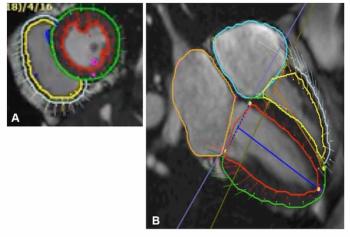
MRI finds growing clinical applications
Few MR applications have held greater promise and encountered bigger challenges than cardiac imaging. MR accurately depicts cardiac structure, function, perfusion, and myocardial viability with a capacity unmatched by any other imaging modality.
Few MR applications have held greater promise and encountered bigger challenges than cardiac imaging. MR accurately depicts cardiac structure, function, perfusion, and myocardial viability with a capacity unmatched by any other imaging modality.
- Morphology. Numerous methods used to depict cardiac structure are referred to as black blood and bright blood techniques. T2-weighted inversion recovery imaging is the frontline black blood sequence. Bright blood imaging yields both morphologic and functional data. Blood generates bright signal intensity, and multiple consecutive images are acquired that can be viewed dynamically to depict cardiac motion. A new approach to improve cine imaging involves a technique known as steady-state free precession.
Fairfax Radiological Consultants in Virginia commonly uses these techniques for evaluation of the pericardium and for structural evaluation of the heart. Depiction of a thickened pericardium is relatively simple by MR but is difficult with echocardiography. The occasional pericardial mass or abnormal fluid collection can be evaluated using these sequences. Other indications include evaluation of arrhythmogenic right ventricular dysplasia and differentiation of constrictive versus restrictive pericarditis.
- Cardiac function. MR evaluation of ventricular and valvular function is well established. Quantification of ventricular volumes with MR has been shown to be accurate and more reproducible than echocardiography. In clinical practice, MRI is used much less frequently than echocardiography for the evaluation of cardiac function because of reduced availability, higher cost, and longer exam times. Useful, though possibly less accurate, functional information is already available with echocardiography, which is generally performed within cardiologists' practices.
- Myocardial perfusion. Myocardial regional blood flow is assessed using dynamic MRI during the first pass of a contrast agent. Under pharmacologic stress, a stenotic artery is unable to respond like a healthy vessel, and a perfusion deficit appears in the myocardium.
Myocardial perfusion studies can depict even small, subendocardial regions of myocardial ischemia. The need to infuse a stress agent during the study requires a physician comfortable with its administration to be present. Radiologists sometimes perform this function, but most centers use a cardiologist or internist for this critical aspect of the study. While myocardial perfusion studies offer some improvement over currently available nuclear cardiac studies, we have not been able to develop a routine clinical service.
- Myocardial viability. Identification and differentiation of viable from nonviable myocardium plays a critical role in prognosis for patients with coronary artery disease. MRI has made dramatic progress with the introduction and rapid acceptance of the delayed-enhancement technique (DE-MRI). After an appropriate delay (typically 10 to 20 minutes), breath-hold inversion recovery-prepared, T1-weighted gradient-echo images are acquired.
Viable tissue is dark, while nonviable, fibrotic, or scarred tissue enhances. The amount of enhancement is inversely correlated with recovery of function following revascularization. DE-MRI can visualize small, subendocardial areas of infarction that may be missed by nuclear techniques, including PET. Use of DE-MRI has grown rapidly. The studies are easy to do and involve no stress agents or monitoring.
- Coronary MRA. The coronary arteries, very small structures residing on a beating heart in a respiring chest, are the most difficult arterial circulations to image using MR. While many techniques have been investigated, none has received universal acceptance. Recent studies have shown increased accuracy, especially for detection of patients with left main stem or three-vessel disease.13 But exam time, reliability, and ease of use continue to be major practical impediments to clinical acceptance. Clinically, we perform coronary MR primarily for suspected anomalous coronary arteries.
- Congenital heart disease. Clinical management of patients with congenital heart disease depends on characterization of cardiac morphology and evaluation of hemodynamics. Traditionally, cardiac catheterization and echocardiography are used to assess these patients.
Cardiac MRI can in many cases completely evaluate cardiac and vascular morphology, venoatrial connections, visceral situs, and extracardiac abnormalities. We have worked with pediatric and adult cardiologists specializing in congenital heart disease and have used MR in many cases to replace or reduce the need for cardiac catheterization.
Newsletter
Stay at the forefront of radiology with the Diagnostic Imaging newsletter, delivering the latest news, clinical insights, and imaging advancements for today’s radiologists.


